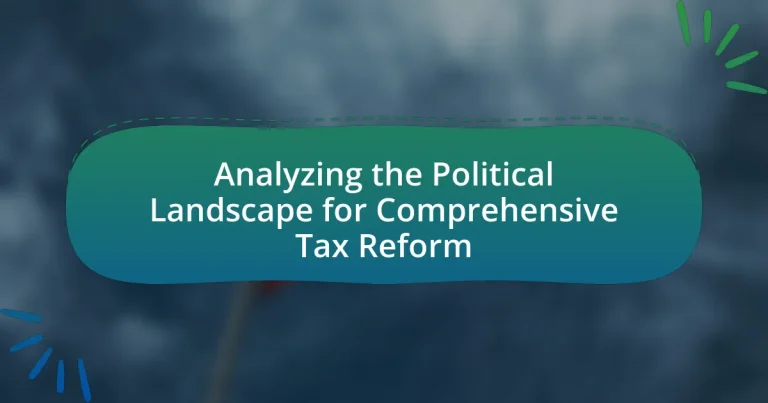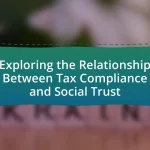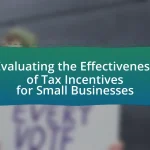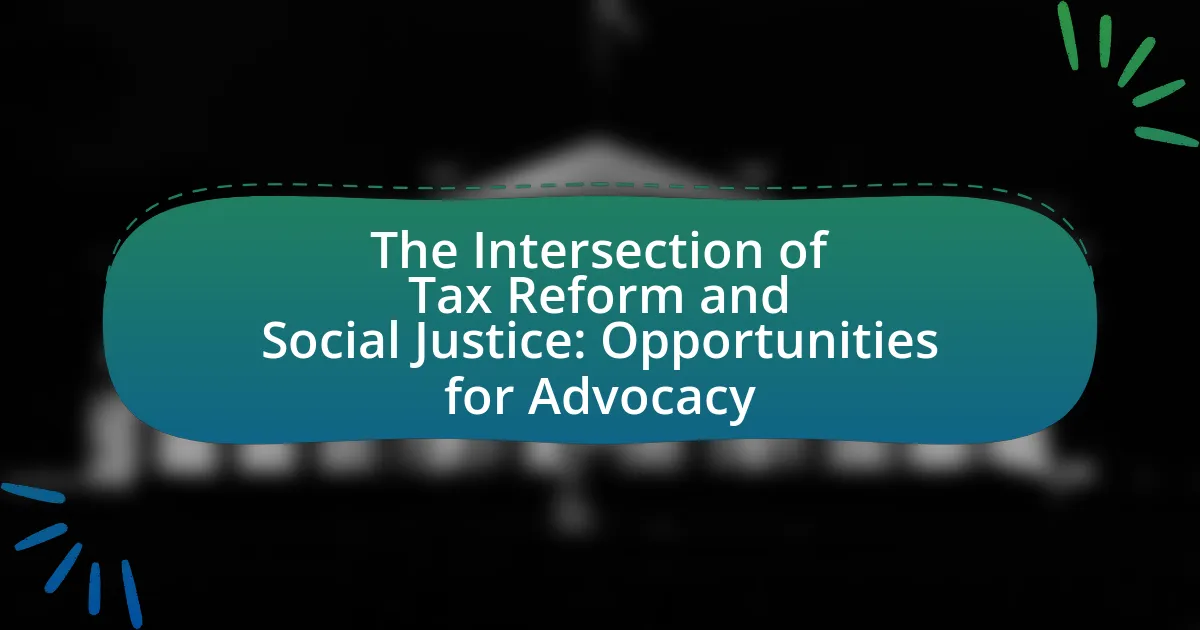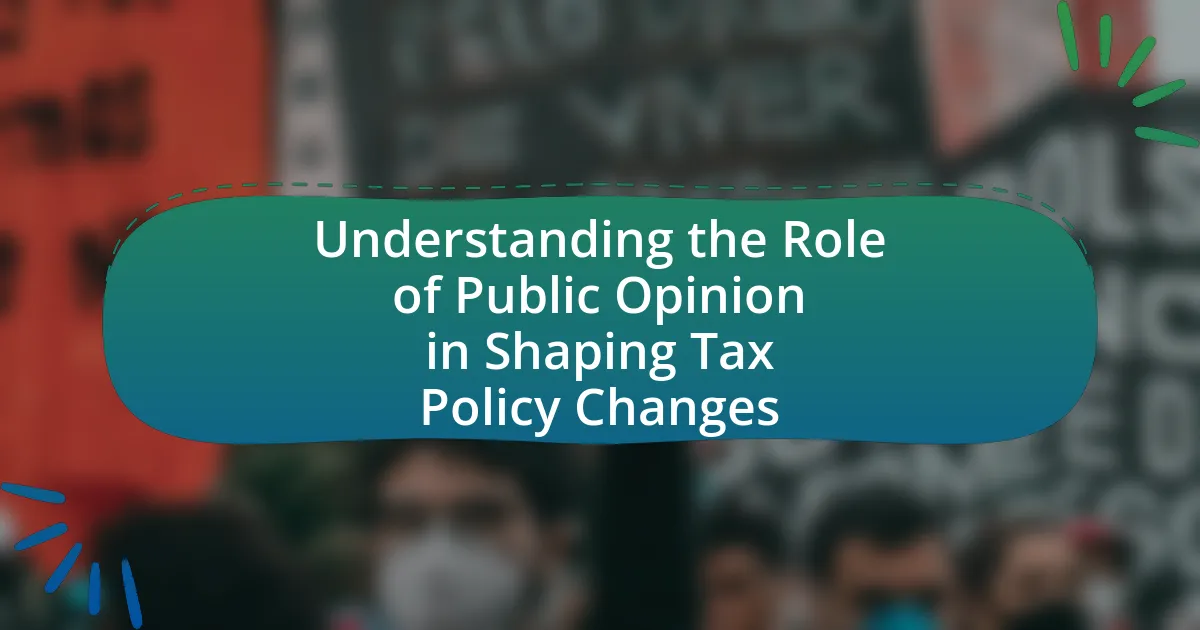The article analyzes the political landscape surrounding comprehensive tax reform, highlighting the significant partisan divisions between Democrats and Republicans regarding tax policies. It discusses how these divisions influence legislative efforts, with Democrats advocating for higher taxes on the wealthy to fund social programs, while Republicans typically support tax cuts to stimulate economic growth. Key factors shaping the tax reform debate include party ideology, public opinion, and lobbying efforts, which collectively impact the feasibility of proposed reforms. The article also examines current trends in tax reform discussions, specific proposals being considered, and the roles of various stakeholders in shaping tax policy outcomes.
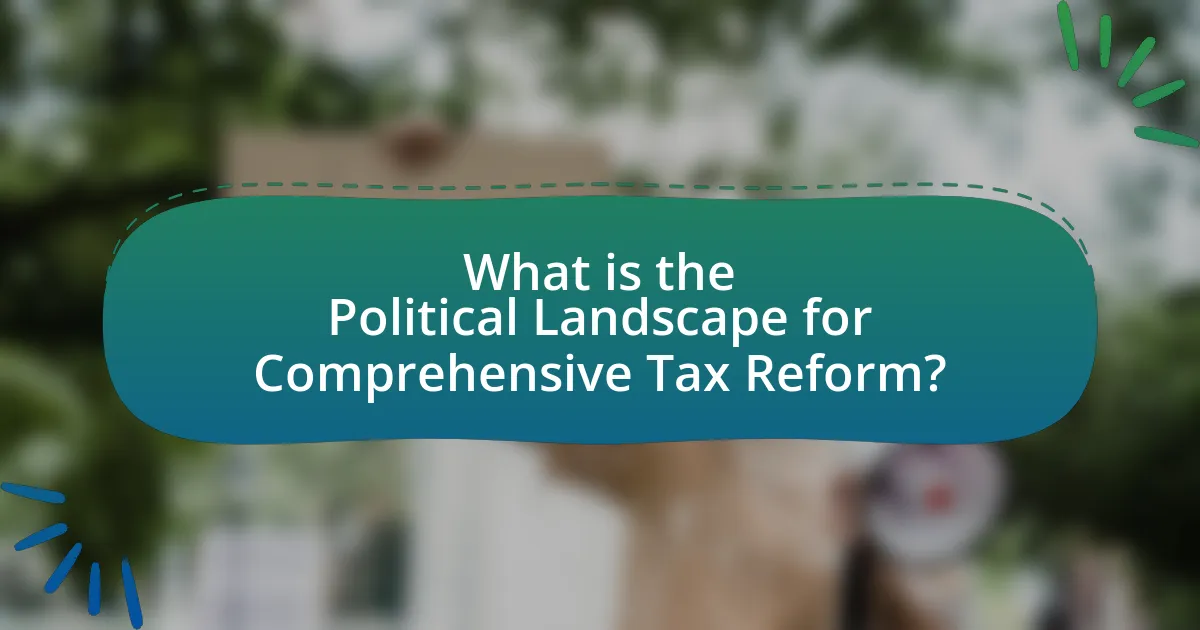
What is the Political Landscape for Comprehensive Tax Reform?
The political landscape for comprehensive tax reform is characterized by significant partisan divisions, with Democrats generally advocating for higher taxes on the wealthy to fund social programs, while Republicans typically support tax cuts and deregulation to stimulate economic growth. This division is evident in legislative efforts, such as the Tax Cuts and Jobs Act of 2017, which primarily benefited corporations and high-income earners, reflecting Republican priorities. Conversely, Democratic proposals, such as those put forth by President Biden, aim to increase taxes on corporations and the wealthy to address income inequality and fund infrastructure and social initiatives. The current political climate, influenced by the balance of power in Congress and public opinion on taxation, complicates the prospects for achieving comprehensive tax reform, as bipartisan support remains elusive.
How does the political landscape influence tax reform initiatives?
The political landscape significantly influences tax reform initiatives by shaping the priorities and feasibility of proposed changes. Political parties and their ideologies dictate the direction of tax policy, with conservative factions typically advocating for lower taxes and reduced government spending, while liberal factions often support higher taxes on the wealthy to fund social programs. For instance, the Tax Cuts and Jobs Act of 2017, driven by a Republican majority, exemplified how a favorable political environment can facilitate substantial tax reform. Additionally, public opinion and lobbying efforts can sway political leaders, impacting the likelihood of reform initiatives being introduced or passed. Historical data shows that tax reforms are more successful when aligned with the ruling party’s agenda and public sentiment, highlighting the critical role of the political landscape in shaping tax policy outcomes.
What key political factors shape the tax reform debate?
Key political factors that shape the tax reform debate include party ideology, interest group influence, public opinion, and the political climate. Party ideology significantly affects tax reform proposals, as conservative factions typically advocate for lower taxes and reduced government spending, while liberal factions often support higher taxes on the wealthy to fund social programs. Interest groups, such as business associations and labor unions, exert pressure on lawmakers to shape tax policies that align with their interests, influencing the direction of the debate. Public opinion also plays a crucial role; surveys indicate that voter preferences can sway politicians’ positions on tax reform, especially during election cycles. Lastly, the political climate, including the composition of Congress and the presidency, determines the feasibility of proposed reforms, as seen in the 2017 Tax Cuts and Jobs Act, which was passed under a Republican-controlled Congress.
How do political parties differ in their approach to tax reform?
Political parties differ significantly in their approach to tax reform, primarily based on their ideological beliefs and economic priorities. For instance, conservative parties typically advocate for lower taxes and reduced government spending, believing that this approach stimulates economic growth and encourages investment. In contrast, liberal parties often support higher taxes on the wealthy to fund social programs and reduce income inequality, emphasizing the role of government in providing public services. Historical evidence, such as the Tax Cuts and Jobs Act of 2017, illustrates the conservative approach, which aimed to lower corporate tax rates, while the Affordable Care Act included tax increases on higher earners, reflecting the liberal stance on tax reform.
Why is tax reform a critical issue in the political landscape?
Tax reform is a critical issue in the political landscape because it directly impacts economic growth, income inequality, and government revenue. Policymakers recognize that an effective tax system can stimulate investment and job creation, as evidenced by studies showing that lower corporate tax rates can lead to increased business expansion. Additionally, tax reform addresses disparities in wealth distribution; for instance, the Congressional Budget Office reported that the top 20% of earners hold over 50% of the nation’s income, highlighting the need for a more equitable tax structure. Furthermore, tax reform is essential for ensuring sustainable government funding, as outdated tax codes can lead to budget deficits and hinder public services.
What economic conditions drive the need for tax reform?
Economic conditions that drive the need for tax reform include rising income inequality, stagnant wage growth, and increasing public debt. Rising income inequality, evidenced by the top 1% holding a disproportionate share of wealth, creates pressure for a more equitable tax system. Stagnant wage growth, where median wages have not kept pace with inflation, necessitates reforms to ensure that tax revenues can support essential public services. Increasing public debt, which has reached levels exceeding 100% of GDP in many countries, highlights the urgency for a tax system that can generate sustainable revenue. These conditions collectively underscore the necessity for tax reform to address economic disparities and fiscal sustainability.
How do public opinions impact political decisions on tax reform?
Public opinions significantly influence political decisions on tax reform by shaping policymakers’ perceptions of voter priorities and preferences. When a substantial portion of the electorate expresses support or opposition to specific tax policies, elected officials often adjust their proposals to align with these sentiments to secure votes and maintain public approval. For instance, surveys conducted by organizations like Gallup have shown that when a majority of citizens favor tax increases on the wealthy, politicians are more likely to advocate for such measures in legislative discussions. This responsiveness to public sentiment is further evidenced by the outcomes of elections, where candidates who align their tax reform proposals with the prevailing public opinion tend to perform better at the polls.
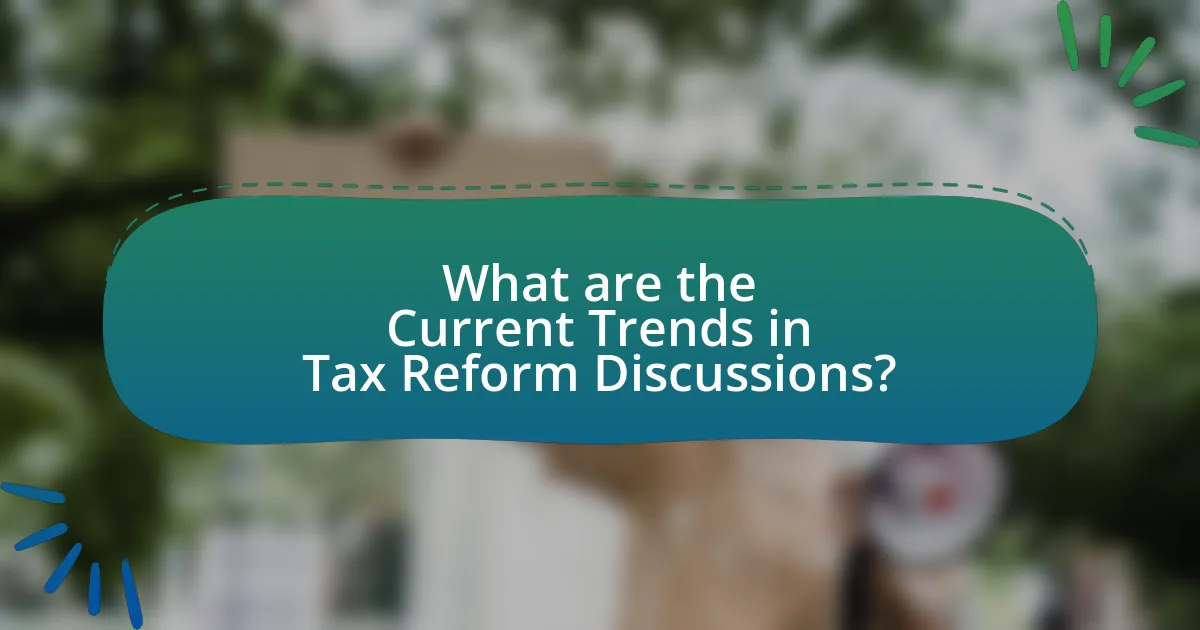
What are the Current Trends in Tax Reform Discussions?
Current trends in tax reform discussions focus on equity, simplification, and sustainability. Policymakers are increasingly advocating for tax systems that address income inequality by implementing progressive tax rates and closing loopholes that disproportionately benefit the wealthy. Additionally, there is a push for simplifying the tax code to enhance compliance and reduce administrative burdens, as evidenced by proposals to streamline deductions and credits. Furthermore, discussions are incorporating sustainability, with considerations for environmental taxes aimed at promoting green initiatives and addressing climate change. These trends reflect a broader shift towards creating a fairer and more efficient tax system that meets contemporary economic challenges.
How are recent political events shaping tax reform proposals?
Recent political events are significantly influencing tax reform proposals by highlighting partisan divides and shifting public priorities. For instance, the ongoing debates surrounding economic recovery from the COVID-19 pandemic have prompted lawmakers to consider tax reforms that address income inequality and support middle-class families. Additionally, the Biden administration’s focus on increasing corporate taxes to fund infrastructure and social programs has led to proposals aimed at closing tax loopholes and ensuring that wealthier individuals contribute a fairer share. These developments reflect a broader trend where political pressures and public sentiment are driving the conversation towards more progressive tax policies, as evidenced by recent legislative efforts and public opinion polls indicating support for higher taxes on the wealthy.
What role do elections play in tax reform agendas?
Elections significantly influence tax reform agendas by determining the political leadership and legislative priorities of a government. Political parties often campaign on specific tax reform proposals, which can shift based on voter preferences and economic conditions. For instance, the 2016 U.S. presidential election saw candidates proposing substantial tax reforms, which were pivotal in shaping the subsequent Tax Cuts and Jobs Act of 2017. This act was largely influenced by the Republican Party’s electoral mandate to reduce corporate tax rates and simplify the tax code, demonstrating how electoral outcomes can directly impact tax policy decisions.
How do lobbying efforts influence tax reform discussions?
Lobbying efforts significantly influence tax reform discussions by shaping policymakers’ perceptions and priorities. Lobbyists represent various interest groups, such as corporations and trade associations, and they provide information, research, and arguments that align with their clients’ goals. For instance, the National Federation of Independent Business has been known to advocate for small business tax cuts, directly impacting legislative proposals. Additionally, lobbying can lead to the introduction of specific tax provisions that favor certain industries, as seen in the 2017 Tax Cuts and Jobs Act, where corporate lobbyists successfully pushed for reduced tax rates for businesses. This demonstrates that lobbying not only affects the content of tax reform but also the overall direction of tax policy discussions.
What are the major challenges facing comprehensive tax reform?
The major challenges facing comprehensive tax reform include political polarization, the complexity of the tax code, and the potential economic impact on various stakeholders. Political polarization often leads to gridlock, making it difficult to reach bipartisan agreements necessary for reform. The complexity of the existing tax code creates confusion and resistance to change, as stakeholders may fear losing benefits or facing higher taxes. Additionally, concerns about the economic implications, such as potential job losses or increased costs for businesses, further complicate the reform process. These challenges are evidenced by historical attempts at tax reform, such as the Tax Reform Act of 1986, which faced significant opposition and negotiation hurdles before achieving success.
What political divisions hinder progress on tax reform?
Political divisions that hinder progress on tax reform include partisan polarization, differing economic philosophies, and regional interests. Partisan polarization, particularly between Democrats and Republicans, creates a significant barrier as each party often prioritizes its own agenda over bipartisan solutions. For instance, Democrats may advocate for higher taxes on the wealthy to fund social programs, while Republicans typically push for tax cuts to stimulate economic growth. Additionally, differing economic philosophies regarding the role of government in the economy further complicate negotiations. Regional interests also play a crucial role, as lawmakers often prioritize the needs of their constituents, leading to conflicts over tax incentives and revenue distribution. These divisions collectively obstruct the development of a cohesive tax reform strategy.
How do economic disparities affect tax reform proposals?
Economic disparities significantly influence tax reform proposals by shaping the priorities and perspectives of policymakers. When income inequality is pronounced, proposals often aim to increase taxes on higher earners to redistribute wealth and fund social programs, reflecting the needs of lower-income populations. For instance, the Tax Policy Center reported that in 2021, the top 1% of earners captured 20% of total income, prompting discussions around progressive tax structures to address this imbalance. Additionally, economic disparities can lead to political polarization, where different socioeconomic groups advocate for divergent tax policies, complicating consensus on reform. This dynamic illustrates how economic inequality directly impacts the formulation and acceptance of tax reform initiatives.
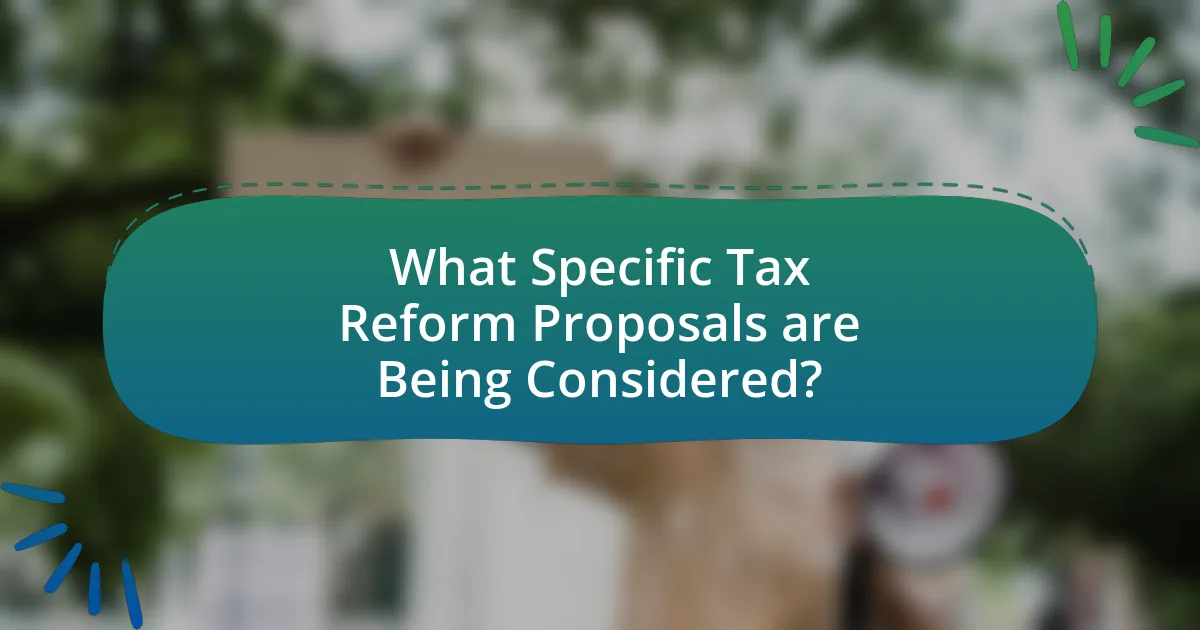
What Specific Tax Reform Proposals are Being Considered?
Specific tax reform proposals being considered include increasing the corporate tax rate, implementing a wealth tax on ultra-high-net-worth individuals, and expanding the Earned Income Tax Credit (EITC) for low- and middle-income families. The Biden administration has proposed raising the corporate tax rate from 21% to 28% to generate additional revenue, while various lawmakers are discussing a wealth tax that could impose a 2% annual tax on assets exceeding $50 million. Additionally, expanding the EITC aims to provide greater financial support to working families, which could significantly reduce poverty levels. These proposals are part of broader discussions on how to address income inequality and fund infrastructure and social programs.
What are the most discussed tax reform strategies?
The most discussed tax reform strategies include broadening the tax base, increasing tax rates on higher income brackets, implementing a carbon tax, and simplifying the tax code. Broadening the tax base involves reducing exemptions and deductions to increase the number of taxable entities, which can enhance revenue without raising rates. Increasing tax rates on higher income brackets aims to address income inequality and generate additional funds for public services. Implementing a carbon tax is proposed as a way to combat climate change while generating revenue. Simplifying the tax code seeks to reduce compliance costs and improve efficiency in tax collection. These strategies are frequently debated in legislative discussions and are supported by various economic studies highlighting their potential impacts on revenue generation and economic equity.
How do these strategies aim to address current tax system issues?
These strategies aim to address current tax system issues by promoting equity, efficiency, and simplicity in tax administration. For instance, implementing progressive tax rates can reduce income inequality, as evidenced by studies showing that countries with higher progressive taxation have lower income disparity. Additionally, simplifying tax codes can reduce compliance costs and improve taxpayer understanding, which is supported by data indicating that complex tax systems lead to higher rates of non-compliance. Furthermore, closing loopholes and eliminating tax breaks for high-income earners can enhance revenue generation, as demonstrated by analyses revealing that such measures can significantly increase government funding for public services.
What are the potential impacts of these proposals on different demographics?
The potential impacts of tax reform proposals on different demographics include variations in tax burden, access to services, and economic mobility. For instance, lower-income households may benefit from increased tax credits and deductions, which can alleviate financial strain, while higher-income individuals may face increased tax rates, potentially reducing disposable income. Additionally, proposals aimed at closing tax loopholes could disproportionately affect wealthier demographics who utilize these strategies. Historical data from the Tax Policy Center indicates that tax reforms often lead to a redistribution of wealth, impacting spending power across income brackets. Thus, the implications of these proposals are significant and varied, affecting economic stability and growth within diverse demographic groups.
How do stakeholders influence tax reform proposals?
Stakeholders influence tax reform proposals by advocating for their interests, shaping public opinion, and lobbying policymakers. Various groups, including businesses, labor unions, and advocacy organizations, engage in lobbying efforts to promote specific tax policies that align with their goals. For instance, the National Federation of Independent Business has historically lobbied for tax cuts that benefit small businesses, demonstrating how organized interests can sway legislative priorities. Additionally, stakeholders often mobilize public campaigns to raise awareness and support for their positions, which can pressure lawmakers to consider their demands in reform discussions. This dynamic interaction between stakeholders and policymakers is crucial in determining the direction and content of tax reform proposals.
What roles do businesses and advocacy groups play in shaping tax reform?
Businesses and advocacy groups play critical roles in shaping tax reform by influencing policy decisions through lobbying, funding research, and mobilizing public opinion. Businesses often advocate for tax policies that favor their interests, such as lower corporate tax rates or specific deductions, which can significantly impact legislative outcomes. Advocacy groups, representing various social, economic, or environmental interests, work to promote tax reforms that align with their missions, such as progressive taxation or increased funding for public services. For example, the National Federation of Independent Business has historically lobbied for tax relief for small businesses, while organizations like the Institute on Taxation and Economic Policy advocate for equitable tax policies. Their combined efforts can sway lawmakers by providing data, expert testimony, and grassroots support, ultimately shaping the direction and content of tax reform initiatives.
How do public interest groups contribute to the tax reform dialogue?
Public interest groups contribute to the tax reform dialogue by advocating for specific policy changes that reflect the needs and interests of the public. These groups engage in research, mobilize grassroots support, and provide expert testimony to influence lawmakers and shape public opinion. For instance, organizations like the Center on Budget and Policy Priorities analyze tax proposals and present data-driven arguments to highlight the potential impacts on low- and middle-income families. Their efforts help to ensure that diverse perspectives are considered in the tax reform process, ultimately aiming for a more equitable tax system.
What are the best practices for engaging in tax reform advocacy?
The best practices for engaging in tax reform advocacy include building a coalition of stakeholders, utilizing data-driven arguments, and effectively communicating with policymakers. Building a coalition allows for a unified voice, increasing influence and credibility; for instance, organizations like the Center on Budget and Policy Priorities have successfully advocated for tax reforms by collaborating with various interest groups. Utilizing data-driven arguments ensures that advocacy efforts are grounded in factual evidence, which can be seen in studies from the Tax Policy Center that analyze the impacts of proposed reforms. Effective communication with policymakers involves tailoring messages to resonate with their priorities and concerns, as demonstrated by successful campaigns that have engaged legislators through targeted outreach and clear messaging.
